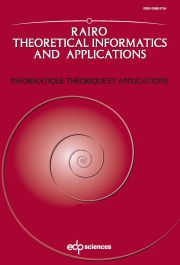Article contents
Circular splicing and regularity
Published online by Cambridge University Press: 15 June 2004
Abstract
Circular splicing has been very recently introduced to model a specific recombinant behaviour of circular DNA, continuing the investigation initiated with linear splicing. In this paper we restrict our study to the relationship between regular circular languages and languages generated by finite circular splicing systems and provide some results towards a characterization of the intersection between these two classes. We consider the class of languages X*, called here star languages, which are closed under conjugacy relation and with X being a regular language. Using automata theory and combinatorial techniques on words, we show that for a subclass of star languages the corresponding circular languages are (Paun) circular splicing languages. For example, star languages belong to this subclass when X* is a free monoid or X is a finite set. We also prove that each (Paun) circular splicing language L over a one-letter alphabet has the form L = X+ ∪ Y, with X,Y finite sets satisfying particular hypotheses. Cyclic and weak cyclic languages, which will be introduced in this paper, show that this result does not hold when we increase the size of alphabets, even if we restrict ourselves to regular languages.
- Type
- Research Article
- Information
- Copyright
- © EDP Sciences, 2004
References
- 10
- Cited by


